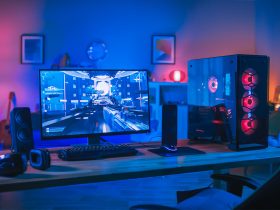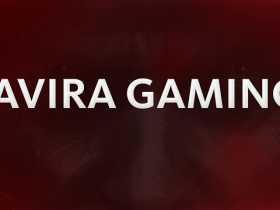Want to be a warrior on the ultimate quest? Gamers have the freedom to immerse themselves in impossible, magical virtual worlds, but PC performance is crucial to gaming performance and the experience. Welcome to our speed guide for gamers—it’s packed with ways to help get your PC into tip-top shape for gaming. We’ll explore what factors affect PC performance, and how to boost your FPS for faster, smoother gaming. Plus, discover the free tool that helps clean out and optimize your PC.
It’s not just you… in gaming, PC performance counts too
When you’re moving in for the kill or are a micro-second away from victory there are few things more frustrating than a stuttering machine, loads of lag, and slow… load… times. For passionate players, gaming is more than a mere experience. It’s an important source of identity and community—but exceptional gaming requires outstanding performance from both hardware and software.
Unlike with games consoles, PC games aren’t optimized for your specific hardware as developers simply can’t test every possible configuration. Also, PCs are workhorses that tend to perform many different tasks, so background programs can hog their resources. Cleaning out your PC can help improve general performance, but that’s not enough for ambitious gamers and modern games.
Read on to explore the soft- and hardware upgrades, settings, and tweaks that can improve the gaming performance and help turn game playing into an eye-wateringly immersive experience. Optimize your machine for gaming and properly maintain it, and you’ll be rewarded with smoother animations, fewer interruptions, and greater speed—not to mention higher image resolutions and richly detailed textures. Plus, taking care of your hardware helps keep the components cool and running more efficiently, so you can help extend the life of your machine. That’s a win-win before you’ve even started playing!
Let’s start with public gaming enemy number 1: low FPS and how to banish it.
What is FPS and why do you want it to be high?
When games are displayed on your screen, they consist of a fast sequence of images called frames and the number of frames your monitor displays in one second is the frames per second (FPS) or frame rate. For added oomph when gaming, you’ll want to boost FPS. (If you’re wondering where the images come from, the video card generates these frames using data it receives from the games program running on your PC).
Games are demanding. Did you know that videos usually run at about 24fps but games running at this speed will look jumpy and jagged? That’s because videos include a ‘motion blur’ that smooths over the images to create a coherent, moving whole. A game has no blur so you’re jumping noticeably from one frame to the next. The gold standard for a good gaming FPS is considered to be around 60, which is good news because it’s also the frame rate that standard monitors run at. It’s not worth getting overly ambitious and trying to boost your FPS beyond this—you’ll simply run into the limitations of your monitor and experience no added benefits. Unless… you’re prepared to invest in a gaming monitor. These have higher refresh rates of 120Hz or 144Hz so they can display additional frames, for an even smoother gameplay experience.
Here’s how to view the refresh rate of your laptop or monitor screen:
- Right-click the desktop window and select “Display settings”.
- Scroll down to choose “Advanced display”.

- Your display information opens.

What is your FPS during a game? It’s easy to find out:
- Press the Windows and G keys simultaneously.
- Click on the Performance button. Several menus will open.
- The FPS rate is tucked into the Performance box. If there is no game currently running, this value will not be displayed.

Many PC games have an option in the “Video Settings” menu to display FPS. You can also use Fraps to view the FPS in any game.
There are many reasons why you may have a low FPS. Old or slow graphics cards will battle to keep up with demanding games, for example. Outdated drivers are another common culprit behind slow speed and less stability. Top tip: It’s easier to stay on top of software and driver updates with a software updater. Avira Free Software Updater updates common software and drivers for more stable performance (plus plugging security loopholes in outdated software helps keep you safer too).
Read on to explore how to help fix these issues and understand the hardware and software that’s essential to better gaming.
Optimize hardware for gaming, step 1: It’s all about the GPU
The graphics process unit or GPU is vital to gaming performance because it renders the 2D and 3D images, scenes, and animations that you see on screen. (Basically, without a GPU, there would be no way to output an image to your display). Good graphics performance means that games can be played at a higher resolution and with faster frame rates. All PCs come with an integrated GPU which is fine for browsing the web, doing simple productivity tasks with Microsoft Office, and even for light gaming. If you’re a heavyweight gamer with a love for face-meltingly awesome graphics and multiple monitors, you’ll need a dedicated GPU. This next section is for you before you head off to play that AAA game title.
To do! Update your graphics card driver to for better FPS. Here’s how to update your GPU driver for Intel HD Graphics cards, Nvidia GeForce, and ATI Radeon. Please remember never to download software from unverified third-party sites!
- Intel HD Graphics: These are usually found in ultrabooks or tablets and the newer Intel GPUs can deliver solid performance for today’s games. See the Intel Download Center for the latest drivers and select the blue “Get started” button to automatically update your drivers.

You’ll then be given the option to download the Intel Driver and Support Assistant Application. After downloading, follow the on-screen prompts to install the software.

- Nvidia GeForce: You’ll find the latest official GeForce drivers on their website, which promises to enhance your gaming experience and run apps faster. Search for your graphics card and Windows version or opt for automatic driver updates by downloading GeForce Experience.

- ATI Radeon: The AMD software downloads website lets you search for your specific device, so you’ll be able to download the latest official driver for your GPU. You can also try a newer beta driver for the most up-to-date features and a bigger boost in FPS.

It’s worth the effort. A higher-end graphics card can deliver better performance, higher resolutions, and more detailed visuals. But you’re not done yet. You may have to upgrade other parts of your PC to cope with the demands of your new, power-hungry GPU.
Optimize your CPU: Keep it cool and overclock if necessary!
Welcome to the brains of your machine: The central processing unit or CPU is responsible for processing and executing instructions. The CPU is not the memory (where information is temporarily stored) and it’s also not the graphics card which renders the video and 3D graphics that are displayed on your screen. A healthy CPU is essential to a system that’s well-optimized for gaming so here are some tips:
Monitor your CPU temperature: High temperatures can lead to thermal throttling, where your CPU reduces its performance to prevent overheating. Make sure that your CPU is adequately cooled by using a reliable cooling solution. Also regularly clean any dust buildup on your CPU cooler and ensure proper airflow around your machine.
Optimize power settings: Your computer’s power settings should be set to “High Performance” or a similar setting to maximize CPU performance during gaming sessions. You can adjust power settings in the Windows Control Panel or the power management options in your computer’s BIOS/UEFI.
Close unnecessary background processes: Remember to close unnecessary programs or processes running in the background that could consume CPU resources. If it’s not essential for gaming, switch it off!
Overclock your CPU: Overclocking involves running your CPU at higher clock speeds than the manufacturer’s specifications. This can provide a performance boost in gaming. Do be careful as overclocking may require additional cooling and can void warranties. Proper research and understanding of your specific CPU model and safe overclocking techniques are essential!
Optimizing your CPU alone may not provide significant performance gains if it’s other components that are the limiting factors. Read on to find out how to solve challenges if RAM or storage holding are holding you back.
Make the most of all your gaming hardware
There are other upgrades or tweaks you can make to help ensure that your PC is resilient enough for the latest games.
- Is it time for more RAM?
Think of an agile workspace that’s handling many different tasks. That’s your computers short-term memory. It’s called ‘random access memory’ or ‘RAM’ and makes whatever your computer is currently doing possible. Adding RAM gives your PC more power to work with, helping optimize it for gaming and other tasks. Here’s a guide: If you’re looking to boost your FPS to 60 or more at high resolutions, you’ll need at least 16 GB of RAM (and a powerful graphics card)—although 32GB or more is even better for high-end games. It’s not all about capacity though. Faster RAM speeds can result in faster data transfer and enhanced performance so look for RAM with higher MHz ratings too. Warning! Always make sure that the RAM you choose is compatible with your motherboard and CPU.
- Replace your traditional hard drive with a solid-state drive (SSD)
SSDs work without moving parts so they can help speed up load times and improve system responsiveness and overall performance but there are important recommendations: Choose an SSD with enough storage capacity for your operating system, files, and games. Also consider read and write speeds. SSDs with higher read and write speeds offer quicker data transfers.
- Don’t forget your peripherals: Keyboard, mouse, and monitor
For a more immersive and visually stunning experience make sure to adjust your monitor settings for refresh rate, color calibration, and response time. You can also optimize your keyboard and mouse settings for more comfortable and efficient gaming, so you can make specific in-game actions or execute complex commands more easily.
Take a hard look at software for gaming optimization
It’s tempting to think that powerful hardware upgrades are always the answer, but basic software maintenance can also squeeze more performance out of your machine. If your machine is suddenly slower than usual, are you sure malware isn’t the issue? Do a quick scan with a reputable anti-virus solution. Avira Free Security comes with a diverse set of features to help protect you from online threats weak passwords, and more.
Are you still clicking away annoying update reminders? Then the next section is essential reading. Let’s start with the operating system (OS) as this is the software ‘scaffold’ that supports a high-quality experience and will affect important details of how the game is run. Updates are essential as newer versions of the OS may include new features, optimizations, and bug fixes that could improve performance. And don’t forget to keep your games software current too! These updates allow game developers to fix any issues which may appear after the game has been launched. Your CPU is no exception either and CPU drivers and firmware need regular updating: Manufacturers often release updates that can improve performance and address compatibility issues. Visit the website of your CPU manufacturer to download and install the latest versions for your CPU model.
Although updates are a good thing, an update being downloaded when you’re in the middle of a game will devour your bandwidth. So, it’s a good idea to deactivate automatic updates for the duration of your game.
- Press the Windows key + I to open Settings. Then click “Update & Security”.
- Click “Windows Update” from the menu on the left. Then select “Advanced Options”.
- You can choose to temporarily pause updates or set the toggle for “Restart this device as soon as possible when a restart is required to install an update” to Off. Set the toggle for “Show a notification when your PC requires a restart to finish updating” to On.
It’s also worth tinkering with your in-game settings. Turning these down can give you a boost in FPS—for free. You can usually find the options available for a specific game under ‘post-processing’ and ‘special effects.’ These will add things like sunrays, shadows, and motion blur to your game, devouring a lot of processing power for little extra impact. Also disable Aniscopic Filtering. This makes objects ahead of you clearer, but it really puts a strain on your resources! Another way to increase FPS is to change your graphics card performance settings (E.g.: turn power mode to maximum). AMD and NVIDIA allow you to do this using specific control panels and you’ll find instructions on how to do so on their websites.
Defragging (defragmenting) is also a gamer’s friend. This puts all the files that the game needs to run in one continuous space instead of spreading them out all over the hard drive. You should defrag at least once a month, but daily is best. Follow these instructions to defragment your Windows 10 PC.
FPS booster software promises to increase your frame rate in games, but if you’ve already taken other steps to optimize your FPS you may be disappointed with the results. Even the best gaming optimization software simply stops or slows down background processes to free up computing power for gaming. Microsoft included Game Mode in Windows 10, for example, which you can access by pressing the Windows key + G when you’re in a game. You could close those programs directly in Task Manager yourself. Razer offers free software called Cortex which prioritizes processing resources for your game and switches your computer’s CPU to sleep mode.
Too much software and other clutter? Clean up your PC
Is your game competing for precious RAM with a load of programs you don’t really need? That will lower your FPS during gaming so be sure to cut the clutter. Free Avira System Speedup helps tackle the problem in a number of ways: It displays a list of applications that run on start, and lets you postpone or stop the ones you don’t need. It also scans your system for all the stuff it no longer needs, like system cache, temp files, internet junk…Upgrade to the Pro version for automatic optimization and advanced cleaning.
Improve network connectivity to boost your online gaming experience
Are you unnecessarily blaming your Windows PC? If you’re gaming online, optimizing network connectivity is crucial too. Here are some tips to improve your network connection for gaming:
Upgrade your internet plan: Does your current internet plan meet your need for speed when gaming? Higher-speed plans with lower latency and higher bandwidth can greatly enhance your gaming experience.
Use a wired connection: If possible, always connect your gaming device directly to the router with an Ethernet cable. Wired connections provide lower latency and more stable connections than wireless connections.
Reduce network interference: Keep your gaming device close to the router or you may experience interference from other devices. Also try to avoid physical obstructions like a thick wall between you and the router. Wi-Fi range extenders can help extend your network coverage and provide better connectivity in areas where the signal is weak.
Prioritize gaming traffic: Some routers offer Quality of Service (QoS) settings that allow you to prioritize gaming traffic over other network traffic to help reduce latency for a smoother gaming experience.
Disable bandwidth-intensive services: Cloud backups, video streaming, large downloads…we tend to use many bandwidth-intensive services. Pause or disable them while gaming or you could experience lag and high latency.
Optimize router settings: Is your router running the latest firmware version? Also consider adjusting settings like channel selection and signal strength to improve Wi-Fi performance.
Connect to a gaming VPN: Did you know that there are gaming-specific VPN services? These are designed to help reduce latency, protect against DDoS attacks, and connect you to servers in different regions. Game servers that are geographically closer to your location tend to provide a smoother gaming experience.
Now get your PC game-ready!
You may not need a top-of-the-range new PC with blazing fast speeds to take you on your next virtual mission. Making sure your hardware and software are running at their best, fine-tuning the monitor, game, and mouse settings, minimizing background apps, and freeing up space will help keep your machine running at its peak for longer. If you do have money to burn and want to feel like you’re really slipping into the spurs of the outlaws in Red Dead Redemption 2, for example, upgrade your graphics card and consider an SSD.
But there are several steps you can take for free, or at least for much less than the cost of an entirely new set-up. Free Avira System Speedup is a great place to start fine-tuning your Windows PC and getting it game-ready.








